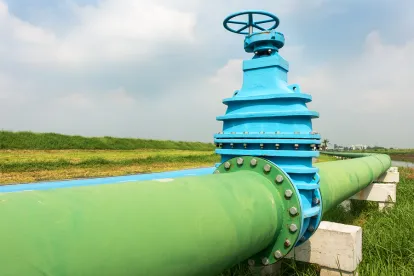PHMSA Stays Enforcement of 45th Edition of API Specification 5L
On May 1, the Pipeline and Hazardous Materials Safety Administration (PHMSA) issued a notice announcing that it will not enforce the 45th edition of American Petroleum Institute (API) Specification 5L, “Specification for Line Pipe,” if an operator demonstrates compliance with the more stringent provisions of the 46th edition of API Spec. 5L. The 45th edition, dated December 2012, is incorporated by reference into the federal regulations, but PHMSA will allow operators to comply with the 46th edition, dated April 2018, which contains more stringent pipe end-straightness tolerances, clarifies how to define and measure end-squareness, and includes new annexes addressing welded jointers and pipe used in strain-based design.
PHMSA’s notice remains effective until a final rule is issued addressing the 46th edition of API Spec. 5L.
PHMSA Rulemakings Update. The chart below shows the status of PHMSA’ pending pipeline safety rulemaking initiatives as reflected in the Department of Transportation’s (DOT) April Significant Rulemaking Report, PHMSA’s status Chart of legislatively mandated actions, and the Office of Management & Budget’s Office of Information and Regulatory Affairs (OIRA) Fall 2018 Unified Agenda of Regulatory and Deregulatory Actions. The Unified Agenda appears in two principal parts, Current Agenda Agency Regulatory Entries for Active Actions and Current Long Term Actions.
Consistent with an April 11 Executive Order (EO) directing PHMSA to revise safety regulations applicable to liquefied natural gas (LNG) facilities, DOT has added “Amendments to LNG Facilities,” to the April Significant Rulemaking Chart. Among other things, the EO requires that PHMSA issue new regulations updating the Part 193 LNG safety standards to reflect best practices and best-available technologies. To the maximum extent possible, new regulations must reflect risk-based standards. The EO also requires PHMSA to issue regulations allowing the transportation of LNG by rail car within 13 months.
New information appears in bold.
Pending Final Rules
|
|
Underground Natural Gas Storage Facilities |
August 27, 2019 |
December 2018 |
July 2, 2019 |
Pending Notices of Proposed Rulemakings
|
Pending Advance Notices of Proposed Rulemakings
|
Proceeding |
DOT Estimated Publication |
OIRA Estimated Publication |
PHMSA’s Chart |
|
Coastal Ecological Unusually Sensitive Areas |
Not Listed |
April 2020 |
Not Specified |
Other PHMSA Updates
PHMSA amends drug testing regulations to reflect recent DOT requirement to test for opioids. On April 23, PHMSA issued a final rule making technical corrections to drug testing regulations to ensure consistency with 2017 amendments requiring that DOT-regulated drug testing programs test for oxycodone, oxymorphone, hydrocodone, and hydromorphone, i.e. opioids. The final rule amends Part 199’s definition of a Prohibited Drug to directly reference DOT’s Part 40 regulations governing drug testing procedures. PHMSA also is updating the Management Information System (MIS) form to be consistent with this change.
PHMSA issues advisory bulletin reminding pipeline operators of the risk of damage caused by earth movement. On May 2, PHMSA issued an advisory bulletin to operators of gas and hazardous liquid pipelines cautioning that earth movement caused by landslides and subsidence in variable, steep and rugged terrain can damage pipelines and threaten their integrity. The advisory bulletin reminds operators that existing regulations require that pipeline facilities be designed to consider load imposed by geological forces and that operators actively monitor and address risks associated with geological hazards. The advisory bulletin recommends that operators take numerous steps to mitigate the risk of damage caused by earth movement, including identifying areas prone to earth movement; using geotechnical engineers when designing, constructing, and operating a pipeline system; developing site- specific design, construction and monitoring plans and procedures that address identified hazards; and developing mitigation measures to remediate identified locations. The advisory bulletin also identifies specific monitoring and mitigation measures that operators should consider.
Updates on Reauthorization of the Pipeline Safety Act
On May 1, the Subcommittee on Energy of the House Energy and Commerce Committee convened a hearing on “The State of Pipeline Safety and Security in America.” Witnesses included PHMSA Administrator Howard “Skip” Elliott, the Acting Director of the Government Accountability Office (GAO) W. William Russell, Commissioner Lawrence Friedeman of the Public Utilities Commission of Ohio, and representatives of the Association of Oil Pipelines, the American Gas Association, and the Pipeline Safety Trust. Prepared statements, testimony, and a video link to the hearing, is here.






 />i
/>i
